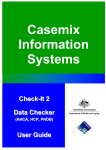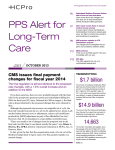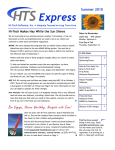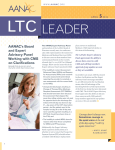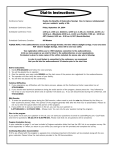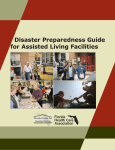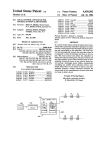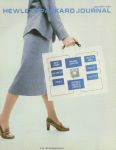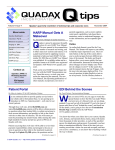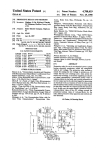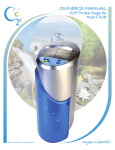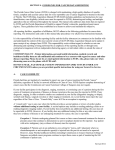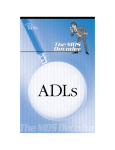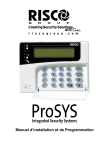Download CMS revising 3.0 timeline
Transcript
March 2009 Vol. 12, No. 3 MDS 3.0 update New 3.0 timeline in the works CMS revising 3.0 timeline Agency aiming for October 1 implementation At the January SNF/Long-Term Care Open Door Forum, amid industry rumors that this year’s planned MDS 3.0 implementation would be delayed, a CMS official said Although officials said CMS planned to stick to the October 1 deadline for the new assessment system, it will change the original timeline, which had a March release date of the final MDS 3.0 form and RAI Users’ Manual. In January, many long-term care providers noticed the agency is still pursuing an October 1 implementation. that CMS had re- However, officials also stated that CMS will revise its orig- moved its MDS 3.0 inal MDS 3.0 timeline. implementation The agency is “working aggressively toward” the October 1 implementation date, Mary Pratt, director of the division of postacute and chronic care at CMS, said “One of the things we’re timeline from its Web site. CMS identified some inaccuracies at the forum. “That being said, it is also important to mention that with the timeline doing is looking at all of the moving parts, and I’m making sure that our work plans and timeline take everything into account.” —Sheila Lambowitz stakeholders have been expressing concern about the and is planning to revise it, agency officials said at the implementation of the MDS 3.0, which is currently forum. scheduled for October 1, 2009,” Pratt said. “We ac- “We’re evaluating the whole process, and we’ll let you knowledge that the time frame is ambitious, and your know as soon as we can,” Sheila Lambowitz, director comments and issues related to the implementation are of the division of institutional postacute care at CMS, under consideration.” said when asked whether the agency still planned to release the final MDS 3.0 form in March. IN THIS ISSUE p. 3 Working with the media Telling your facility’s story can show the community what the five-star quality rating system doesn’t measure. p. 6 Five-star update Long-term care industry associations are working with CMS to improve the five-star rating system. p. 7 PPS Q&A Rena R. Shephard, MHA, RN, RAC-MT, C-NE, answers questions about coding pain and ADLs and setting the ARD. p. 9 Reducing restraints A Pennsylvania nursing facility that has been restraint-free for seven years offers insight into how to reduce restraint use. “Right now, we’re still moving forward,” Lambowitz said. “We just want to make sure we cover all the bases and we address all the issues before we put a revised timeline back up there.” CMS will also reschedule some of the MDS 3.0 trainthe-trainer events originally planned for this spring, she said. MDS 3.0 and RUG-IV Long-term care providers still don’t have an answer as to when CMS will release the next iteration of the resource utilization group (RUG) system, often referred to as RUG-IV, or how a new RUG system would interact with the MDS 3.0. > continued on p. 2 PPS Alert for Long-Term Care Page 2 MDS 3.0 March 2009 < continued from p. 1 When asked by a caller whether CMS had an estimated time of arrival for RUG-IV, Lambowitz said changes to the RUG system will roll out in the SNF PPS regulation, current RUG system if it couldn’t meet its date for the final rule. CMS officials will evaluate that situation when they which would require proposed and final rules to be pub- have a better idea of when the proposed rule will be re- lished in the Federal Register. leased, Lambowitz said. “Basically, I can’t tell you without Since the proposed rule requires a 60-day comment my crystal ball … exactly what date it will go out, but we period before the final rule can be issued, officials will watch these things very carefully,” she said, adding that aim to release the proposed rule in April in order to issue she also couldn’t answer questions about how interre- the final rule by July 31, she said. lated the MDS 3.0 and RUG-IV would be or how the 3.0 “But we do have to do significant work to do briefings through a whole series of internal and external stakeholders, including [Office of Management and Budget], so we can’t you give you an exact date,” said Lambowitz. Officials were also asked whether the MDS 3.0 would be moved or whether CMS would revert to using the Editorial Advisory Board PPS Alert for Long-Term Care Group Publisher: Emily Sheahan Associate Editor: Emily Beaver, [email protected] Sandra Fitzler Senior Director of Clinical Services American Health Care Association Washington, DC Bonnie G. Foster, RN, BSN, MEd Long-Term Care Consultant Columbia, SC Cindy Frakes Owner Winter Meadow Homes, Inc. Topeka, KS Julia Hopp, MS, RN, CNAA, BC Vice President of Patient Accounting Paramount Health Care Company San Antonio, TX Steven B. Littlehale, MS, GCNS-BC Executive Vice President, Healthcare Chief Clinical Officer PointRight, Inc. Lexington, MA Mary C. Malone, JD Healthcare Attorney, Director Hancock, Daniel, Johnson & Nagle, PC Richmond, VA Steven B. Littlehale, MS, GCNS-BC Executive Vice President, Healthcare Chief Clinical Officer PointRight, Inc. Lexington, MA Ronald A. Orth, RN, NHA, RAC-CT, CPC President Clinical Reimbursement Solutions, LLC Milwaukee, WI Rita Roedel, MS, RN National Director of Clinical Reimbursement Extendicare Health Services, Inc. Milwaukee, WI Rena R. Shephard, MHA, RN, RAC-MT, C-NE PPSA Senior Advisor Founding Chair and Executive Editor American Association of Nurse Assessment Coordinators President RRS Healthcare Consulting Services San Diego, CA Holly F. Sox, RN, RAC-C MDS and Staff Development Coordinator NHC Lexington West Columbia, SC PPS Alert for Long-Term Care (ISSN: 1521-4990 [print]; 1937-7428 [online]) is published monthly by HCPro, Inc., 200 Hoods Lane, Marblehead, MA 01945. Subscription rate: $239/year. • PPS Alert for Long-Term Care, P.O. Box 1168, Marblehead, MA 01945. • Copyright © 2009 HCPro, Inc. • All rights reserved. Printed in the USA. Except where specifically encouraged, no part of this publication may be reproduced, in any form or by any means, without prior written consent of HCPro, Inc., or the Copyright Clearance Center at 978/750-8400. Please notify us immediately if you have received an unauthorized copy. • For editorial comments or questions, call 781/639-1872 or fax 781/639-2982. For renewal or subscription information, call customer service at 800/650-6787, fax 800/639-8511, or e-mail: [email protected]. • Visit our Web site at www. hcpro.com. • Occasionally, we make our subscriber list available to selected companies/vendors. If you do not wish to be included on this mailing list, please write to the marketing department at the address above. • Opinions expressed are not necessarily those of PPSA. Mention of products and services does not constitute endorsement. Advice given is general, and readers should consult professional counsel for specific legal, ethical, or clinical questions. © 2009 HCPro, Inc. would affect state case-mix payment systems. “One of the things we’re doing is looking at all of the moving parts, and I’m making sure that our work plans and timeline take everything into account,” Lambowitz said. “So we will be giving answers to those questions fairly soon, but not today.” New administration, new rules Providers may have heard that President Barack Obama’s administration has established a moratorium on regulations put in place toward the end of former President George W. Bush’s administration and regulations CMS put in place during the latter half of 2008, Lambowitz said. The new administration will reevaluate those regulations. “In terms of how they affect the nursing home industry and your operations, we really haven’t had any SNF or long-term care regulations that were moving through Online extra As the long-term care industry awaits the MDS 3.0, we know you have plenty of questions about the new assessment system. We’re tracking MDS 3.0 developments at www.mdscentralonline.com to keep you updated as soon as CMS releases news. If you have a specific MDS 3.0 question, visit www. mdscentralonline.com and click on the Ask Diane icon to submit your question. We’ll notify you as soon as CMS releases the information you’re looking for. For permission to reproduce part or all of this newsletter for external distribution or use in educational packets, contact the Copyright Clearance Center at www.copyright.com or 978/750-8400. PPS Alert for Long-Term Care March 2009 the system that were caught in this freeze,” Lambowitz said, adding that the last payment regulation for SNFs was made in July 2008. “We have been moving forward on competitive bid- Page 3 Still waiting for pain tag Long-term care providers are still waiting for revised guidance on F309, Quality of Care, pain management. A caller to the January 29 CMS SNF/Long-Term Care ding for [durable medical equipment], and there is a reg- Open Door Forum asked CMS officials when the revised ulation that is on hold pending a reevaluation. But other guidance on F309, the pain tag, would be posted on the than that, we’re not aware of anything that affects you CMS Web site and whether the general investigative and directly,” Lambowitz said. Dispelling 3.0 rumors CMS is working with the intention of giving providers pain management protocols would be effective March 31. CMS sent long-term care surveyors a memo dated January 23 containing revised guidance on F309, including new general and pain management investigative protocols, with an effective date of March 31. The caller asked wheth- updates on the MDS 3.0 and disseminating information er providers should observe the effective date or wait until to all stakeholders, Pratt said. The updates will be deliv- CMS posts the materials. ered through the open door forum listserv or posted at www.cms.hhs.gov. “If you hear any other information, please use those sites to verify any other announcements because those will be the official vehicles by which we send out the word on any updates on implementation,” Pratt said. n Sheila Lambowitz, director of the division of institutional postacute care at CMS, didn’t have an immediate answer to the question. “I know the pain material is out for review, but we don’t have a date,” Lambowitz said, adding that providers should wait until CMS officially posts information. Telling your facility’s story in a five-star era Now that consumers can access star ratings for nursing facilities on the Internet, telling the public about Building relationships with the media Establishing relationships with members of the media your facility’s special programs and unique benefits is is important, says Carol Marshall, MA, a long-term more important than ever. care consultant in Fort Worth, TX, and author of an up- If your facility has tried to get your local newspaper or television station to cover a special event, you know the coming HCPro book about customer satisfaction in longterm care. challenges of getting media coverage: fewer writers and If you have a relationship with a reporter, you’ll have reporters at many media outlets, press releases that dis- a friend when you want coverage of a special event or appear in the newsroom, and staff members at your fa- achievement and when you must respond to a bad sur- cility who are too busy to deal with the media. vey, an elopement, or a lawsuit, Marshall says. Working with the media can help you tell your com- You can establish a good relationship with the media munity about your nursing facility’s award-winning staff by pitching feature stories, sending quality news releas- or creative activities program. A long-term care consul- es and photos, and responding to media inquiries in a tant and the director of marketing, communications, and timely way, says Sarah Soden, director of marketing, PR for a long-term care organization explain strategies communications, and PR at United Methodist Homes, for building relationships with the media, relaying your a nonprofit organization that operates several nursing facility’s message, and responding to negative coverage. © 2009 HCPro, Inc. > continued on p. 4 For permission to reproduce part or all of this newsletter for external distribution or use in educational packets, contact the Copyright Clearance Center at www.copyright.com or 978/750-8400. PPS Alert for Long-Term Care Page 4 Five-star March 2009 < continued from p. 3 and long-term care facilities in New York and Pennsyl- 3. Attend the event and identify residents who are will- vania. Establishing your facility as a helpful resource will ing to be interviewed. Make sure you have signed give members of the media confidence that you will pro- consent forms on file for any residents who are inter- vide them with honest information in a timely manner, viewed or photographed. 4. Give reporters a more detailed press release (e.g., one Soden says. Marshall suggests keeping in touch with members containing the history behind an event) and your of the media about long-term care industry news and contact information in case they have additional making your staff members available as expert sources. questions after the event. This can help you build relationships with reporters, 5. Soden also takes photos, interviews residents, and and reporters may appreciate getting a lead on a story, writes her own story for her facility’s newsletter or she says. Web site. Working with the media When you invite members of the media to your fa- In 2008, Soden helped United Methodist Homes get television news coverage for a vow-renewal ceremony for residents, a gallery opening for art created by young cility, remember that you are inviting them into your residents’ home. Your residents have the same expectation of privacy as children in a United Methodist Homes day care, and a you do at your home. Don’t volunteer residents for in- certified nursing assistant who received an Excellence in terviews without their permission, and make sure any Caregiving award from the Central New York chapter of residents who are interviewed have the required men- the Alzheimer’s Association. tal capacity, Soden says. One of Soden’s rules about working with the media is never invite reporters to events that aren’t truly unique Responding to bad news or interesting. If you invite members of the media to dull At times, your facility may have to respond to nega- or routine events, they may not show up when you have tive news coverage, such as a story about a bad survey, a great one. a lawsuit, or a poor rating under the five-star system. When you invite the media to your facility, make it as Your facility or corporate organization should appoint easy as possible for reporters to get the information they one person as a media representative or spokesperson. If need, Soden says. you don’t have a PR director, your administrator might She takes the following steps when enlisting media coverage for special events: 1. Send out a press release well in advance of the event be the appropriate spokesperson. Train staff members not to speak to the media and to refer any inquiries to the designated spokesperson, says with basic information (e.g., who will be there, the Marshall. She suggests that the spokesperson tell the contact information of your facility’s media represen- media you are investigating a problem rather than refus- tative, and the event’s purpose, importance, and date ing to comment. and time). Also, tell the press whether they can get photographs or video footage. 2. Ask members of the media to let you know whether “If you slam the door on the media, they’ll run away with the story,” Marshall says. Develop strong internal communication and antici- they’ll be coming. If you don’t hear from anyone, fol- pate negative coverage so you can prepare a response, low up with a phone call. Soden says. © 2009 HCPro, Inc. For permission to reproduce part or all of this newsletter for external distribution or use in educational packets, contact the Copyright Clearance Center at www.copyright.com or 978/750-8400. PPS Alert for Long-Term Care March 2009 Page 5 “Be honest and up front about the situation. ‘No some of the information posted on the Web site. Doneski comment’ just prolongs the life of an issue in a news says she hopes the information will also be useful to con- cycle,” she says. sumers who may be trying to evaluate information about a nursing facility. Answering five-star questions With all the attention the five-star rating system has CMS says consumers should visit nursing facilities in person, but that suggestion may be difficult to find received, nursing facilities may already be fielding calls among the other information about nursing home rat- from the media about their star ratings. ings on the agency’s Web site. Doneski also recom- When the rating system was unveiled in December, United Methodist Homes explained how the rat- mends that consumers visit www.longtermcareliving.com for information about selecting a nursing home. ings were calculated, why the organization’s facilities For more details about AHCA’s efforts to work with received their ratings, and what they are doing to im- CMS to improve the five-star rating system, see “Five- prove, Soden says. star update” on p. 6. “We also explained our organization’s take on the rating system and why the star ratings don’t make for a Talking about satisfied customers complete picture of our facilities and services,” she says. One way to respond to questions about your facil- You can read an article United Methodist Homes ity’s star rating—especially if you didn’t get five stars— posted on its Web site about the rating system at www. is with your customer satisfaction survey, says Marshall. unitedmethodisthomes.org/news/viewarticle.asp?a=3079. > continued on p. 6 The American Health Care Association (AHCA) has posted information about the five-star rating system on its Web site at www.ahcancal.org, including quality talking points and myths and realities about the rating system. When the five-star rating system was released, some nursing facilities were contacted by members of the media before they had seen their ratings, says Lyn Bentley, MSW, director of regulatory services at AHCA. One reason AHCA posted the information was to help nursing What CMS says about five-star CMS gave long-term care providers a preview of their rating under the five-star quality rating system one week before the ratings were refreshed with the past two months of data on the Nursing Home Compare Web site in late January, CMS officials said at the January SNF/Long-Term Care Open Door Forum. Since the ratings have been refreshed with new data in facility staff members who may not be experienced in February and March, providers should have been able to dealing with the media. preview their ratings before they were posted on Nursing “A director of nursing or administrator’s business is get- Home Compare. CMS also plans to open a Nursing Home ting people to care for people,” says Donna Doneski, Compare hotline the week before and after the ratings are director of public affairs at AHCA, who helped assemble updated so providers can ask questions about how their ratings were calculated, officials said. Questions? Comments? Ideas? Contact Associate Editor Emily Beaver Telephone 781/639-1872, Ext. 3406 E-mail [email protected] © 2009 HCPro, Inc. The hotline number is 800/839-9290, and providers can see their star ratings at www.medicare.gov/nhcompare. At the open door forum, CMS officials said they expected to refresh the data February 26. Agency officials also confirmed that they have been speaking with stakeholder groups regarding the five-star quality rating system. For permission to reproduce part or all of this newsletter for external distribution or use in educational packets, contact the Copyright Clearance Center at www.copyright.com or 978/750-8400. PPS Alert for Long-Term Care Page 6 Five-star March 2009 < continued from p. 5 You can survey your customers with commercially “Many people still hold ideas about nursing homes produced surveys or create a survey program. When you that are 20 years or more out of date,” Soden explains, receive the results, make an effort to work on areas your adding that she always has positive and timely sto- customers were unhappy with, then survey your custom- ries to tell about events at United Methodist Homes ers again, Marshall says. facilities. After you conduct a strong customer satisfaction sur- By telling their stories, your staff members can be vey, include the results in: your best advocates in helping the public understand ➤➤ Your facility newsletter or Web site the value and role of long-term care in your community, ➤➤ Newspaper ads she says. ➤➤ Flyers or handouts ➤➤ Presentations your staff members give during local speaking engagements ➤➤ Your facility brochure Working with members of the media can help nursing facilities change the perception that nursing home residents are recipients of the community, not givers to it, says Marshall. If any of your residents knit caps to donate to home- Changing perceptions about long-term care Working with the media gives your facility an opportunity to educate the community about long-term care. less shelters or send care packages for troops overseas, telling their story can show the public that your residents are still vibrant members of the community. n Five-star update Members of three long-term care industry associations intended for, Bentley says. As a result, a facility that admits met with CMS in January to discuss their concerns about many postsurgical patients may be penalized under the rat- the five-star rating system released in December 2008. ing system because its QMs show a high incidence of pain. The American Health Care Association (AHCA), the Ameri- However, it may be expected for residents to experience can Association of Homes and Services for the Aging, and pain after surgery and doesn’t necessarily indicate wrong- the Alliance for Quality Nursing Home Care met with Thom- doing on the facility’s part. as Hamilton, director of the survey and certification group Bruce Yarwood, president and CEO of AHCA, wrote CMS two detailed letters during summer 2008 expressing con- at CMS. Hamilton was willing to clear the agenda to listen to the cerns about problems in the rating system. industry groups’ concerns, says Lyn Bentley, MSW, direc- The rating system is having a broad effect on the long- tor of regulatory services at AHCA, who was involved in the term care community, Bentley says. Many providers are strug- meeting. gling to explain their ratings to families, and staff members CMS plans to form four work groups, which will include feel demoralized by poor star ratings. One administrator who some industry advocates, to identify ways to improve the called Bentley said she lost two admissions because of her rating system, Bentley says. The groups will focus on quality star rating, even though the administrator believed her facil- measures (QM), staffing, surveys, and consumer satisfaction. ity was excellent. CMS will determine which issues can be resolved quickly, and which must be addressed over the long term, she says. One major problem is that the rating system uses information from QMs to rank facilities, something QMs were never © 2009 HCPro, Inc. AHCA is encouraging providers to monitor their star ratings and ensure that the information used to arrive at the rating is accurate, Bentley says. Providers should also ask CMS questions, such as why a recent survey wasn’t included. For permission to reproduce part or all of this newsletter for external distribution or use in educational packets, contact the Copyright Clearance Center at www.copyright.com or 978/750-8400. PPS Alert for Long-Term Care March 2009 Page 7 PPS Q&A Editor’s note: “PPS Q&A” is written by Rena R. Shephard, assistance required. A higher level cannot be coded un- MHA, RN, RAC-MT, C-NE, founding chair and executive ed- til the ADL occurred at least three times. See the defini- itor of the American Association of Nurse Assessment Coordina- tions in Chapter 3 of the RAI User’s Manual. tors and president of RRS Healthcare Consulting Services in San Diego. To submit a question, contact Associate Editor Emily We are having a debate about how to calculate MDS Beaver at [email protected]. minutes for group therapy. The regulations say no more than 25% of therapy time can be in group thera- A resident had horrible/excruciating pain once dur- py, so we make sure that the number of therapy minutes ing the observation period. She was given a medi- doesn’t exceed the number we get when we divide the cation, and the pain was relieved without recurrence total number of minutes in P1b by four. Now we’re told during the observation period. Does the result of the we’re doing it incorrectly. Please explain the process. intervention affect the coding of the pain in J2a, pain frequency, and J2b, pain intensity? Would it be coded 0, To calculate the allowable 25% for group treatments, no pain, because it was relieved promptly? simply multiplying the total number of minutes by 25% is incorrect. The following formula, which must be No, the result of the intervention does not affect the calculated separately for each therapy discipline (i.e., phys- coding of pain. The question you must answer is ical therapy, occupational therapy, and speech-language whether there was pain during the observation period. If pathology), can be used to calculate the allowable 25% the answer is yes, code the frequency in J2a and the high- for group treatments that can be counted on the MDS: est intensity the pain reached in J2b, even if it reached 1. Individual minutes divided by 0.75 = total allowable minutes (individual plus group minutes) that intensity only once during the observation period. The RAI User’s Manual states, “Code the highest inten- 2. S ubtract individual minutes from total allowable min- sity of pain that occurred during the observation period utes to determine the maximum number of group in J2b. Code for the presence or absence of pain, regard- minutes available to the resident for the MDS less of pain management efforts” (p. 3-141). In the ex- ample provided, J2a would be coded 1, pain less than The following are two examples of these calculations: daily, and J2b would be coded 3, times when horrible ➤➤ 250 individual minutes divided by 0.75 = 333 allowable minutes. 333 allowable minutes minus the 250 or excruciating. individual minutes = maximum of 83 minutes perIf a person ambulates in the hall only once in the seven-day lookback period for G1, activities of daily living (ADL), is it coded as 8, activity did not occur, since mitted for group treatments for this resident. ➤➤ 300 individual minutes divided by 0.75 = 400 allowable minutes. 400 allowable minutes minus 300 it didn’t occur the three or more times necessary to assign a code? Correction No. If it happened even once, it occurred, and 8 is not the correct code. If the activity occurred only once or twice in the observation period, the instructions are to code it 0, independent, regardless of the level of © 2009 HCPro, Inc. > continued on p. 8 A question in the January PPSA Q&A incorrectly stated that a resident was admitted to the emergency room November 20. The question should have listed the date the resident was admitted to the emergency room as November 29. For permission to reproduce part or all of this newsletter for external distribution or use in educational packets, contact the Copyright Clearance Center at www.copyright.com or 978/750-8400. PPS Alert for Long-Term Care Page 8 Q&A March 2009 < continued from p. 7 individual minutes = maximum of 100 minutes per- Because the resident has been discharged from mitted for group treatments for this resident. Part A, you cannot do the assessment now, and you cannot bill the default rate in this situation. In other The RAI User’s Manual states: For groups of four or fewer residents per supervising thera- words, the facility will receive no payment for the stay. The 2009 PPS final rule made this clear and reiterat- pist (or assistant), each resident is coded as having received ed the following five circumstances under which a facil- the full time in the therapy session. For example, if a thera- ity may bill the default rate in the absence of a required pist worked with three residents for 45 minutes on training RAI, as outlined in the Provider Reimbursement Manual: to return to the community, each resident received 45 min- ➤➤ The stay is less than eight days within a spell of illness utes of therapy so long as that does not exceed 25% of his/her ➤➤ The SNF is notified on an untimely basis or is un- therapy time per therapy discipline, during the 7-day observation period. Remember, code for the resident’s time, not for the therapist’s time. Note: The 25% rule applies only to Medicare A residents. (p. 3-188). aware of a Medicare Secondary Payer denial ➤➤ The SNF is notified on an untimely basis of the revocation of a payment ban ➤➤ The beneficiary requests a demand bill ➤➤ The SNF is notified on an untimely basis or is un- I have a resident who was in the facility on Part A for aware of a beneficiary’s disenrollment from a Medi- 12 days and converted to Medicaid on day 13, which care Advantage plan was yesterday. No one realized that the assessment reference date If the resident had not been discharged from Part (ARD) hadn’t been set for the five-day assessment. I’m A and was still in your facility on Part A, a late assess- confused about how to handle this. ment could be completed with a current ARD, and the default rate would be billed for all of the days out of Illustration by David Harbaugh compliance. In this case, the ARD would be set for today, day 14, and the resource utilization group calculated by the assessment would be effective today. Thus, the facility would bill the default rate for days one through 13. You can read about these regulations in the final rule at http://edocket.access.gpo.gov/2008/pdf/e8-17948.pdf. Editor’s note: Due to a production error in the February PPSA Q&A, part of Shephard’s answer was omitted. The question and complete answer are reprinted below. I am trying to understand the projection in section T. How can it be okay to bill for a category if the min- “She just coded all the residents’ ADLs and forgot all the subtasks.” © 2009 HCPro, Inc. utes haven’t been provided? Also, if the projection shows that the resident will get enough minutes to reach the For permission to reproduce part or all of this newsletter for external distribution or use in educational packets, contact the Copyright Clearance Center at www.copyright.com or 978/750-8400. PPS Alert for Long-Term Care March 2009 Page 9 Rehab Very High category, why does the facility get paid projecting therapy days and minutes for the first 15 days at the Rehab High level? of the Medicare stay. The projection must be based on the treatment plan resulting from the evaluation. The The projection, which covers the first 15 days of process is as follows: the Part A stay, allows the facility to be paid for the 1.Look at the number of minutes/days of therapy doc- level of services the resident is expected to receive, even though that level of rehab might not be delivered during the seven-day observation period of section P1b. The limitation is that the resident cannot classify into the highest rehab resource utilization groups—Rehab umented in section P 2. Based on the treatment plan, project how much more therapy the resident is expected to receive from the day after the assessment reference date through day 15 3. Add the two together; that’s your projection Very High and Rehab Ultra High—using this projection, regardless of the number of minutes projected. The only Facilities should routinely audit the accuracy of pro- way to classify into these two categories is by delivering jections by comparing them to the amount of therapy the actual days or minutes required for the categories as actually provided. At times, projected days/minutes will entered in item P1. not be delivered because the resident was too tired or The instructions for completing section T are in Chapter 3 of the RAI User’s Manual. It explains the process for got sick. Most of the time, the projection should be fairly accurate or it probably isn’t being done correctly. n Case study Taking away restraints, one resident at a time overall quality of life, says Patt Vitale, RN, director of nursing services at Partridge-Tippett. After reading this article, you will be able to: ➤➤ State the definition of a restraint according to the State Operations Manual ➤➤ Name the regulation limiting restraint use in long-term care facilities ➤➤ Explain why reducing restraints in long-term care is important for resident care ➤➤ Discuss strategies for reducing restraint use Reducing restraints has been one of the great success stories in long-term care during the past two decades, according to a CMS report issued in November 2008. The percentage of nursing home residents physically restrained daily declined from 21.1% in 1991 to 5% in 2007, according to the report. However, many long-term care facilities are still using some physical restraints, believing restraints are necessary for resident safety. Operating a restraint-free nursing facility may seem Restraints can endanger residents and are not proven like an unattainable goal, but it has been a reality at one to reduce falls, according to CMS. Using unnecessary Pennsylvania nursing facility in recent years. physical and chemical restraints can result in poor sur- The Partridge-Tippett Nursing Facility, which is part of the United Methodist Homes’ Wesley Village Campus vey results for nursing facilities. Partridge-Tippett now serves as a training site for other in Pittston, PA, has been restraint-free for the past seven area nursing facilities that want to reduce restraints. Un- years, according to staff members. As a result, the facili- derstanding Partridge-Tippett’s approach to eliminating ty has experienced fewer falls and residents have a better © 2009 HCPro, Inc. > continued on p. 10 For permission to reproduce part or all of this newsletter for external distribution or use in educational packets, contact the Copyright Clearance Center at www.copyright.com or 978/750-8400. PPS Alert for Long-Term Care Page 10 Restraints March 2009 < continued from p. 9 restraints by creating a restraint reduction task force and Physical restraints can lead to strangulation and adopting an interdisciplinary approach may help your death from asphyxiation, loss of muscle tone and de- facility reduce restraints. creased bone density, and loss of dignity, among other problems, according to CMS’ November 2008 report Reasons to reduce restraints The 1987 Nursing Home Reform Act established residents’ right to be free from chemical and physical restraints imposed for discipline or convenience and not required to treat the resident’s medical symptoms. Long-term care facilities that are found to use physical restraints not required to treat the resident’s medical symptoms may be cited with F221 or with F222 for chemical restraints not required to treat medical symptoms. Beyond regulatory compliance, there are several im- on restraints. Falls that occur when residents are restrained often result in more serious injuries, the report states. Staff members at Partridge-Tippett found that eliminating restraints decreased falls, Vitale says, noting that the number of falls at Partridge-Tippett is lower than the 1.5 falls per bed per year benchmark. Eliminating restraints also improves residents’ wellbeing in other ways. Mary Lou Langdon, RN, who is now a unit manager at Partridge-Tippett, says she re- portant reasons to reduce restraints, including the seri- members working as a night shift nurse at a time when ous risks physical restraints can pose for residents. restraints were more common in nursing homes. “There are inherent dangers, and people can die,” says Janie Krechting, RN, C, BSN, MGS, LNHA, adjunct professor at the College of Mount St. Joseph in Cincin- Some residents would stay awake all night trying to get out of their restraints, Langdon says. When residents are not restrained, they are more nati. Restraints can become dangerous if residents get comfortable, sleep better, and have a better quality of trapped or tangled in them, Krechting says. life, she adds. MDS 3.0 question of the month Trends in nursing home restraint use My automation vendor recently contacted me 25% and told me the company will not be going forWhat should I do? To read Regulatory Specialist Diane Brown’s answer to this question, visit www.mdscentralonline.com. Click on the Ask Diane icon and then on the Diane Brown link above her picture. Diane answered this question on January 26. If you don’t see the answer on the page, click on the Next Page link until you find January 26. 21.1% Precentage of residents in daily restraints ward with producing new software for the MDS 3.0. 20% 15% 5% 5% 0% 1991 1996 2001 2007 Calender year like to submit? Ask your question on the Ask Diane page at © 2009 HCPro, Inc. 10% 10% Editor’s note: Do you have an MDS 3.0 question that you’d www.mdscentralonline.com. 17.2% Source: CMS. For permission to reproduce part or all of this newsletter for external distribution or use in educational packets, contact the Copyright Clearance Center at www.copyright.com or 978/750-8400. PPS Alert for Long-Term Care March 2009 Steps to restraint reduction One of Partridge-Tippett’s first steps toward becom- Page 11 equipment, but it was able to eliminate many restraints by thinking of creative interventions. ing restraint-free was to create a restraint reduction task force. The task force, which began 12 years ago, included members of the nursing staff, social services, and therapy and activities departments. Each week, members of the task force would identify a resident who had restraints, review his or her medical record, and work together to identify ways to eliminate the restraints, Langdon says. Every member of the team is important, say PartridgeTippett staff members. Therapy department members evaluate the resident’s Evaluating residents as individuals A key to identifying restraints and reducing their use is recognizing that what may restrain one individual (e.g., a half bedside rail) may not restrict another. This requires evaluating individual residents, says Krechting. The Long-Term Care State Operations Manual defines physical restraints as “any manual method or physical or mechanical device, material, or equipment attached or adjacent to the resident’s body that the individual cannot remove easily which restricts freedom of movement or movement and find chairs the resident can sit in with- normal access to one’s body.” The manual defines chemi- out being restrained. cal restraints as “drugs used for discipline or convenience The activities department finds appropriate activities and not required to treat medical symptoms.” for residents because when they are engaged in an activ- “Freedom of movement” means any change in place ity they enjoy, they aren’t focusing on trying to get out or position for the body or any part of the body that the of their chair, which may result in a fall. person is physically able to control, according to a June One benefit to Partridge-Tippett’s approach was that many of the steps were inexpensive, Vitale says. The 2007 CMS memo issued to state survey agency directors. “Remove easily” means that the manual method, device, facility had to evaluate staffing time and purchase some > continued on p. 12 Tips for reducing restraints Even if your facility doesn’t have a restraint reduction pro- ➤➤ Make a team. Forming a restraint reduction task force gram, the following tips will help you reduce the use of re- was one of the first steps Partridge-Tippett took toward straints at your facility: eliminating restraints. The facility involved members of ➤➤ Start at the top. Get your nursing facility’s adminis- its nursing staff, social services, and therapy and activities tration to commit to reducing restraints at your facility, says Patt Vitale, RN, director of nursing services departments in the task force. ➤➤ Take it slowly. Partridge-Tippett eliminated restraints at the Partridge-Tippett Nursing Facility in Pittston, PA. by evaluating one resident at a time and brainstorming After you have support from the top levels of your or- ways to remove restraints. ganization, you can work on getting the entire staff to buy in. ➤➤ Look for alternatives. A low bed may work as an alternative to a bedside rail, Krechting says. ➤➤ Go less restrictive. If your facility must use a restraint, ➤➤ Learn from other facilities. Partridge-Tippett was use the least restrictive method possible. For example, identified as a training site for facilities that want to re- remove a restraint during meals or activities when direct duce restraints. Look for nursing facilities with strong re- supervision is available, says Janie Krechting, RN, C, straint reduction programs in your area. Also, your state BSN, MGS, LNHA, adjunct professor at the College of may have a restraint reduction task force that can pro- Mount St. Joseph in Cincinnati. vide you with resources. © 2009 HCPro, Inc. For permission to reproduce part or all of this newsletter for external distribution or use in educational packets, contact the Copyright Clearance Center at www.copyright.com or 978/750-8400. PPS Alert for Long-Term Care Page 12 Restraints March 2009 < continued from p. 11 material, or equipment can be removed intentionally by resident prior to the usual time, Janeski says. This might the resident the same way it was applied by staff mem- help a resident avoid falling when traveling to the bath- bers (e.g., the resident puts down bedside rails rather room and allow the facility not to restrain the resident. than climbing over them). The memo’s clarifications of those terms were meant to be used in conjunction with Educating families and staff members Many nursing facilities are reluctant to eliminate re- the definition of physical restraints. Creating individualized plans for each resident was a top priority in Partridge-Tippett’s restraint reduction program, says Danielle Janeski, NHA, assistant ad- straints because they are afraid of lawsuits from residents’ family members, Krechting says. Educating residents’ families was one of the biggest challenges Partridge-Tippett faced when implementing ministrator at the facility. The facility didn’t take what Janeski calls a “cookiecutter approach” to eliminating restraints: simply re- its restraint reduction program, Janeski says. Many families were concerned that their loved one moving a restraint and not following up with individu- wouldn’t be safe. Some residents had come to the nurs- alized interventions. Instead, staff members would track ing facility from a hospital, where they were confined to residents’ patterns and formulate initial, individualized a bed during treatment, and families weren’t aware their plans or interventions congruent with the patterns. loved ones could be treated without restraints. For example, the team would track a resident’s toileting for a few weeks, establish a pattern, and then toilet the Relocating? Taking a new job? If you’re relocating or taking a new job and would like to continue receiving PPSA, you are eligible for a free trial subscription. Contact customer service with your moving information at 800/650-6787. The facility met with family members and educated them about the benefits of removing restraints. Eventually, families began to like the idea that their loved ones could live free of restraints, Janeski says. Getting the entire staff to buy into the program is also important to the success of a restraint reduction program, and buy-in needs to start at the top, Vitale says. “The commitment needs to begin at the administrative level, where we’re deciding this is the right thing do for our residents,” she says. n PPSA Subscriber Services Coupon Name q Start my subscription to PPSA immediately. Options No. of issues Cost q Electronic 12 issues $239 Shipping Total (PPSAE) q Print & Electronic 12 issues of each $239 (PPSAPE) Order online at www.hcmarketplace.com. Be sure to enter source code N0001 at checkout! Your source code: N0001 N/A $24.00 Title Organization Address City State Sales tax Phone Fax (see tax information below)* E-mail address Grand total (Required for electronic subscriptions) For discount bulk rates, call toll-free at 888/209-6554. *Tax Information Please include applicable sales tax. Electronic subscriptions are exempt. States that tax products and shipping and handling: CA, CO, CT, FL, GA, IL, IN, KY, LA, MA, MD, ME, MI, MN, MO, NC, NJ, NM, NY, OH, OK, PA, RI, SC, TN, TX, VA, VT, WA, WI, WV. State that taxes products only: AZ. Please include $27.00 for shipping to AK, HI, or PR. q Payment enclosed. q Please bill me. q Please bill my organization using PO # q Charge my: q AmEx q MasterCard ZIP q VISA q Discover Signature (Required for authorization) Card # Expires (Your credit card bill will reflect a charge to HCPro, the publisher of PPSA.) Mail to: HCPro, P. O. Box 1168, Marblehead, MA 01945 Tel: 800/650-6787 Fax: 800/639-8511 E-mail: [email protected] Web: www.hcmarketplace.com © 2009 HCPro, Inc. For permission to reproduce part or all of this newsletter for external distribution or use in educational packets, contact the Copyright Clearance Center at www.copyright.com or 978/750-8400. Nursing Continuing Education Exam January–March 2009 A service of PPS Alert for Long-Term Care Accreditation statement: HCPro, Inc., is accredited as a provider of continuing nursing education by the American Nurses Credentialing Center Commission on Accreditation. Credit designation statement: This educational activity for three nursing contact hours is provided by HCPro, Inc. Directions: ➤Fill out your contact information in the space provided. ➤Complete the exam by circling the letter that corresponds to the correct choice for each question. The questions are based directly on content from the January–March issues of PPSA, and you may refer to them as you take the exam. ➤Return all four pages of the exam to us by May 1, 2009. To qualify for three continuing medical education (CME) credits, you must answer at least 80% of the questions correctly—that’s 24 correct answers out of the 30 questions. ➤Upon successful completion of the exam, we’ll e-mail you a certificate that you may use for display and documentation of three CME credits. Name: _____________________________________________ E-mail:_________________________________________________ Nursing license number: ___________________________ Telephone:_____________________________________________ Facility: ____________________________________________ Fax:____________________________________________________ Address (city, state, ZIP): ____________________________________________________________________________________ January 1. Nursing facilities must be able to immediately identify delirium in residents because _______________. a. delirium is over-detected among nursing home residents b.the condition cannot be reversed c. delirium is a manifestation of a more serious condition, such as dehydration or an adverse reaction to medication d.delirium is easy to detect 2. Under the MDS 2.0, nursing facilities assessed residents for delirium by what means? a. Structured cognitive assessments b.Unstructured observations c. Resident interviews d.Nursing facilities did not complete delirium assessments under the MDS 2.0 3. Under draft versions of the MDS 3.0, how will nursing facilities assess for delirium? a. Using structured cognitive assessments b.Interviewing residents c. Reviewing residents’ medical records d.All of the above 4. What kind of assessment must be conducted so nursing facility staff members can complete the confusion assessment method (CAM) under the MDS 3.0? a. Unstructured staff observations b.Family member interviews c. Structured cognitive assessments d.The Mini-Mental Status Exam A service of PPS Alert for Long-Term Care 5. How will assessors get the information they need to complete the CAM under the MDS 3.0? a. By interviewing residents, using clinical judgment, and reviewing medical records b.From the resident’s doctor c. From the resident’s family members d.From nursing facility staff members’ observations 6. How will assessors get the information they need to complete the CAM for residents who cannot be interviewed? a. By using old MDS 2.0 assessments, staff interviews, and chart review b.From the resident’s doctor c. From the resident’s family members d.Nursing facilities do not have to complete the CAM for residents who cannot be interviewed 7. Negative pressure wound therapy is a _____________. a. traditional wound care technique b.wound care technique that uses a pump to apply a vacuum-like pressure to heal wounds c. wound care technique that requires frequent dressing changes d.wound care technique that leaves wounds exposed to the open air 8. A nursing facility should use negative pressure wound therapy ______________. a. after traditional wound care techniques have been unsuccessful b.for any wound c. for prolonged periods d.on wounds with stable black eschar 9. Under the most recent drafts of the MDS 3.0, negative pressure wound therapy ______________. a. is not considered a skilled service b.cannot be reimbursed by any payer c. can be recorded under skin treatments d.is not included under skin treatments 10. Under Medicare, negative pressure wound therapy ______________. a. is not considered a skilled service b.can be reimbursed in addition to the daily rate c. is not reimbursed in addition to the daily rate d.can only be reimbursed if the resident is receiving another skilled service February 2009 11. Which of the following beneficiary notifications is not mandatory for SNFs under any circumstance? a. SNF Advance Beneficiary Notice (ABN) b.Notice of Exclusion from Medicare Benefits (NEMB) c. ABN for Medicare Part B services d.A generic notice (CMS 10123) 12. Issuing an ABN gives a resident the right to ______________. a. appeal to a fiscal intermediary (FI) for the demand bill process b.an expedited review through a Quality Improvement Organization (QIO) c. continue to receive skilled care covered by Medicare d.remain in the nursing facility 13. Issuing an expedited determination notice (EDN) gives a resident the right to ______________. a. appeal to an FI for the demand bill process b.an expedited review through a QIO c. continue to receive skilled care covered by Medicare d.remain in the nursing facility 14. When Medicare Part A services are ending, but the beneficiary will remain in the facility for custodial care or therapy, which of the following notices would a facility issue? a. ABN (or ABN-G) b.SNF ABN/denial letters and EDN c. NEMB d.The SNF is not required to issue any notices 15. When therapy is no longer medically necessary for a resident, but the resident’s family wants to continue therapy under private pay, which of the following notices would a facility issue? a. SNF ABN/denial letters b.ABN (or ABN-G) and EDN c. ABN only d.NEMB Page 2 Nursing Continuing Education Exam—January–March 2009 16. Under which of the following circumstances might an NEMB be issued? a. Part A services are ending, but the beneficiary will remain in the facility for custodial care b.Part B services are ending because they are no longer medically necessary or reasonable c. All Part A and Part B services are ending d.The beneficiary did not have a three-day qualifying hospital stay 17. Transmittal 1106 states that Medicare contractors shall advise providers to use the __________ to inform beneficiaries about the therapy caps. a. NEMB, or a similar form of their own design b.ABN/ABN-G c. SNF ABN/denial letter d.EDN 18. Which of the following beneficiary notifications are issued for the expedited review process? a. SNF ABN/denial letters and ABN (or ABN-G) b.SNF ABN/denial letters and NEMB c. SNF ABN/denial letters only d.A generic notice (CMS 10123) and a detailed notice (CMS 10124) 19. Beneficiaries enrolled in the Medicare Advantage program __________. a. receive all of the same beneficiary notifications as those in the Medicare fee-for-service program b.receive different notifications under the ABN process c. receive different notifications under the expedited review process d.are exempt from the beneficiary notification process 20. Which of the following is not one of the steps facilities should take to ensure that all beneficiary notices are issued properly? a. Determining which staff members are responsible for issuing specific beneficiary notifications b.Assigning responsibility for the beneficiary notification process to one person c. Training more than one staff member to issue notifications d.Inviting the staff members responsible for beneficiary notifications to daily Medicare meetings March 2009 21. The Long-Term Care State Operations Manual defines a physical restraint as ____________. a. clothing or material that restricts freedom of movement or normal access to one’s body b.any manual method or physical or mechanical device, material, or equipment attached or adjacent to the resident’s body that the individual cannot remove easily which restricts freedom of movement or normal access to one’s body c. bedside rails, chairs, or lap belts that restrict freedom of movement or normal access to one’s body d.any device restricting freedom of movement imposed for the nursing facility’s convenience 22. The Long-Term Care State Operations Manual defines a chemical restraint as ____________. a. drugs used for discipline or convenience and not required to treat medical symptoms b.any antipsychotic drug c. any sedative drug d.drugs used in excessive dosage 23. The 1987 Nursing Home Reform Act established ____________. a. residents’ right to be free from chemical and physical restraints imposed for discipline or convenience and not required to treat the residents’ medical symptoms b.residents’ right to be safe from harm caused by falls c. nursing homes’ right to use physical and chemical restraints at their discretion d.the right for family members to decide whether their loved one should be restrained 24. According to a 2008 CMS report on restraint use in nursing facilities, nursing facilities ____________. a. use more daily physical restraints than they did 15 years ago b.use more daily chemical restraints than they did 15 years ago c. use fewer daily physical restraints than they did 15 years ago d.have completely eliminated restraint use 25. According to CMS, restraints have not been proven to lead to ____________. a. strangulation/asphyxiation b.decreased muscle tone c. loss of dignity d.decreased risk for falls Nursing Continuing Education Exam—January–March 2009 Page 3 26. Staff members at the Partridge-Tippett Nursing Facility in Pittston, PA, found that after eliminating restraints, falls at the facility ______________. a. increased in number b.increased in severity c. decreased in number d.did not change in number or severity 27. According to staff members at Partridge-Tippett, families should ______________. a. dictate whether nursing facilities should restrain residents b.receive education from the nursing facility about the benefits of not restraining residents c. not be involved in care planning decisions d.immediately accept a facility’s decision not to use restraints 28. Mary Lou Langdon, RN, a unit manager at Partridge-Tippett, says removing restraints improved the quality of life for residents by ______________. a. allowing them to be more comfortable and sleep better b.permitting them to move about the facility freely c. giving them more dignity d.giving them the ability to socialize with other residents 29. Which was the first step Partridge-Tippett took toward eliminating restraints? a. Asking family members whether they approved of eliminating restraints b.Asking residents whether they would like the facility to eliminate restraints c. Conducting a customer satisfaction survey d.Forming a restraint reduction task force that included members of the nursing staff, social services, and therapy and activities departments 30. Which of the following was not a strategy Partridge-Tippett used to eliminate restraints? a. Finding meaningful activities for residents to engage in b.Educating family members about the benefits of eliminating restraints c. Removing restraints without following up with appropriate interventions d.Tracking residents’ toileting patterns and toileting residents at appropriate times Evaluation 1. Did this CE activity relate to its stated learning objectives? 2. Was the format of this CE activity easy to use? 3. Did we avoid commercial bias in the presentation of our content? 4. Will this activity enhance your professional development? 5. How long did it take you to complete this activity (include reading, exam, and evaluation)? HCPro, Inc., is accredited as a provider of continuing nursing education by the American Nurses Credentialing Center’s Commission on Accreditation. The PPSA editorial advisory board members have signed a vested interest form declaring any commercial/financial stake in this activity. If you have any questions or concerns, please contact customer service at 800/650-6787. Fax or mail your exam and evaluation by May 1, 2009, to PPSA CE Exam, P.O. Box 1168, Marblehead, MA 01945. Fax: 781/639-2982, Attn: Kerry Betsold, CE coordinator. Page 4 Nursing Continuing Education Exam—January–March 2009

















